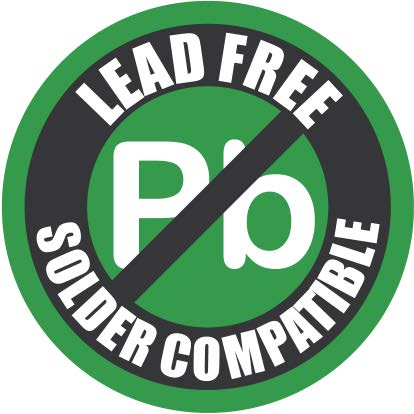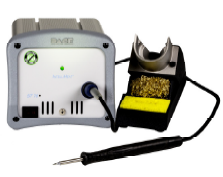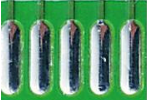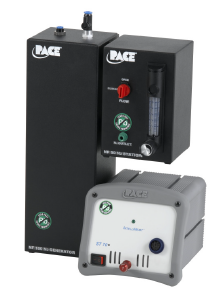Lead-Free Solders and Your Process…
The RoHS deadline has come and gone but many manufacturing and service companies that aren’t servicing international markets are still using leaded solders. With the future political outlook its well within the possibilities (even likely) that a US version of RoHS could be legislated in the near future, forcing US companies to comply. Lead-free solders are generally 95% or more tin (Sn). Tin is corrosive to other metals when molten. Lead-free solder also lacks many of the desirable physical properties that have made lead containing alloys the standard in electronics assembly. There is no single “drop-in-replacement” for leaded, eutectic solder. Some of the most common options include the following alloys in various combinations: Sn/Cu, Sn/Ag/Cu, Sn/In/Cu, and Sn/Ni/Cu. Some of the practical differences between these alloys and their leaded counterparts are:
- Higher melting temperatures.
- Less desirable wetting and spreading properties.
- Difficult to work with.
- More aggressive fluxes required
- Dull grainy finish
Because lead-free solders have higher melting temperatures than solders containing lead, there is an immediate tendency to turn up the temperature on the soldering station. Higher operating temperatures do not make the process quicker and introduce unnecessary risk factors. Leaded solder typically melts at 363 °F and lead-free solders melt in the neighborhood of 425 °F, a soldering iron set at 650 or 700 °F will still melt lead-free solder. The issue isn’t temperature; it’s the ability of your iron/tip configuration to transfer heat to the work efficiently and the heater’s ability to keep up with the heat loss into the work. High performance tips are available from several manufacturers and an evaluation should be undertaken to thoroughly understand how efficiently heat is being transferred from your existing tips to the work.
Lead-free solders generally do not wet or spread as well as lead containing solders. When creating a joint, additional dwell time is needed to ensure a good joint. Turning up the temperature to go “faster” will only result in a poor quality joint. Operators must slow down and be patient. When working with lead-free solders the likelihood of leaving bridges, opens, and insufficient solder defects behind is higher. Again, it is important for operators to be patient and to take their time when creating solder joints.
The old axiom of “Flux is your Friend” is more relevant than ever! Interestingly, rosin containing solders tend to perform better with lead-free solders than ones that do not. Because lead-free solders oxidize quickly, more aggressive and longer lasting fluxes are required to keep the surfaces being soldered clean and free from oxidation. Working with no-clean fluxes can be challenging as their process window is often small. Once they have burned off, oxidation immediately begins to form which can result in a marginal or defective solder joint. Using higher tip temperatures also exacerbates the oxidation issue.
Due to the high tin content in lead free solder alloys, there will clearly be an increase in the likelihood of common defects that have been well under control for years. For example, “tin whiskers” (which can cause bridging and shorting) will return as a more serious problem because the average pitch of today’s component leads is a fraction of what it was 20, 10, or even 5 years ago.
Is Your Existing Rework Equipment Compatible with Lead Free Solders?
There is no doubt that lead-free solders will negatively affect soldering and rework equipment, in particular tip life. When tin mixes with iron (the hard, protective layer on soldering tips), an intermetallic compound is formed that wears away more quickly than the iron would either by itself or when used with lead containing solder. This causes two problems, one is shorter tip life as the protective iron coating is dissolved in the tin, and the second is that oxidation forms more quickly. Once the tin oxides begin to form, the tip will lose its ability to wet with solder, if it is not cleaned off immediately, it becomes almost impossible to remove and the tip will have to be replaced. Many suppliers have moved from providing only a wet sponge to clean the tip to providing an abrasive process (usually metal filings) to clea n the tip which will cause more wear-&-tear on the tip.
n the tip which will cause more wear-&-tear on the tip.
Many new technologies in tip manufacturing have emerged over the last 12 months that are designed to harden the tip to the corrosive effect of lead-free solders. Some manufacturers are using a coating on their tips to add life; others have changed or modified the protective layer of iron on the tip (preferred because it wont wear off); still others have significantly increased the amount of iron on the tip which doesn’t solve the problem -the iron still wears away leaving irregular and/or jagged geometries. The additional iron can also adversely affect heat transfer.
To maximize the life of your soldering tips…
- Always use the lowest effective temperatures while soldering
- Avoid aggressive fluxes whenever possible.
- Always use a properly sized tip for the work. Tips that are too small, will wear out faster and tips that are too large will wear unevenly which, in turn, will change the tip geometry rendering it useless, possibly damaging pads.
- Always “tin” tips when not in use and after cleaning. A coating of solder will prevent the iron from oxidizing in air causing tips to lose their tinning or wetting capability.
- Always feed flux cored solder wire into the heated work, not the tip. Feeding solder directly into the tip will create pin-holes in the iron plating and the tip will fail quickly. It also causes the flux in the solder wire to be burned off before it can activate and properly prepare the surfaces being soldered.
- Should tips lose their tinning or wetting capability, a tip cleaner may be used to restore them.
Does Nitrogen Help?
The use of nitrogen assisted soldering equipment does mitigate some of the problems associated with using lead-free solders. Nitrogen helps on two fronts: first, it creates an inert environment around the soldering tip, reducing the potential for the tip to oxidize which would reduce its ability to transfer heat and hold solder. Second, it assists in the soldering process at the PCB level by purging oxygen from the immediate area which reduces the formation of oxidation on the work site. This helps to improve wetting/spreading and leaves a finish that is shinier and less grainy.
Nitrogen assisted soldering systems pass the nitrogen through or around the heater before it is directed to the work site which “pre-heats” the immediate area and can reduce thermal shock to component leads and to components themselves. Pre-heating also allows for the use of lower, safer and more effective soldering tip temperatures. Nitrogen compatible soldering systems are not significantly more costly than their standard counterparts and many manufacturers offer low cost add-on accessories to utilize N2 in the soldering process.




The preferred option for nitrogen supply is to use an N2 farm. N2 farms harvest N2 from a dry, filtered, compressed air supply that is passed through a specialized filter. The “other atoms” that make up “air” are forced through the filter, leaving a pure stream of N2 as the product of filtering. Nitrogen farms are passive collection devices which means that there are no electrical or moving parts, little or no maintenance, low running costs, and they maintain the balance of O2 /N2 in a confined space (as long as the compressed air is pulled from the same space). Once the N2 has passed through the handpiece and back into the ambient air, it will recombine with the other elements that made up the air molecules before filtering and can be filtered again and again without changing the balance between O2 /N2 concentration ratios in the room. Nitrogen farms are available in a wide range of capacities from single station up to 10 and 20 stations.

